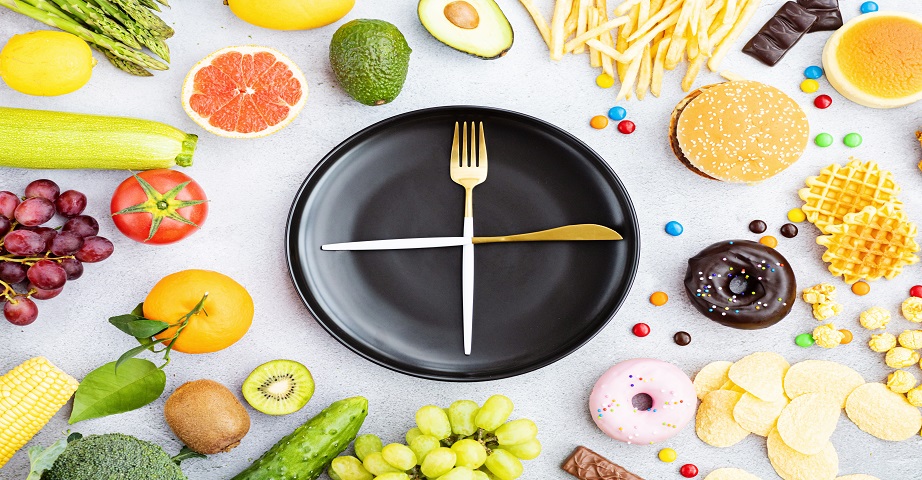Intermittent fasting - a revolutionary model of nutrition? Effects and principles of diet 8/16

The 8/16 diet is a type of intermittent fasting that involves dividing the day into two parts. For 8 hours during the day, called the "dietary window", you can freely reach for food, while during a 16-hour break you should fast, limiting yourself only to consume liquids, which do not provide the body with calories. Is intermittent fasting healthy? How long should it be used to notice the first effects? What is the 8/16 dietary window? What to eat on the IF diet?
Summary
Intermittent fasting - what is it? The rules of the 8/16 diet
Every day in search engines there are questions such as „intermittent fasting - what is it?", „what is intermittent fasting?", „intermittet fasting - rules", or „dietary window-effects", what proves that the 8/16 diet, also known as the 8-hour diet, is an extremely popular form of intermittent fasting.
Intermittent fasting (IF) is a model of nutrition, which has recently gained more and more popularity. It is a way of eating where the most important thing is not WHAT you eat, but WHEN you eat. The IF diet consists in consuming food only during the nutritional window, which is the time of eating meals, and refraining from eating for the remaining, precisely defined, time.
There are different types of intermittent fasting. The most popular ways of IF include the 5:2 method and the 16 by 8 diet. The first option involves the use of a "normal" diet five days a week and the complete resignation of food for two days in a week. In turn, the 8/16 diet is based on a 16-hour fast and a nutrition window that lasts 8 hours and allows you to eat freely. How does it look in practice? If you eat your first meal at 10, you should eat your last meal at 18. Then, by 10 o'clock the next day, you should refrain from eating food. The choice of hours of the nutrition window is, of course, arbitrary and should be adapted to individual needs and preferences. The most important assumption of this model of nutrition is the limited time spent on food consumption.
8/16 diet - for who?
The 8/16 diet is a way of eating, which is most often used by people for whom the goal is to reduce body weight and reduce body fat.
The assumptions of the IF diet are based on the theory that a limited time of eating meals helps in better use of energy, and the fasting period allows using the energy accumulated in the body in the form of adipose tissue. Thus, intermittent fasting is most often used by people who:
- they live an irregular lifestyle,
- they do not want to count calories and follow a specific nutritional plan,
- they used low-energy diets, but did not achieve the desired effect,
- they have a problem with the evening snacking and do not feel hunger from the morning,
- they want to lose weight without giving up their favourite foods.
Intermittent fasting - what to eat?
The 8/16 diet is a model of nutrition that does not require giving up your favourite dishes. When using the 8-hour diet, you can really eat any food. However, in order to maintain full health and notice the desired results faster, the best solution during the 8-hour eating window is to eat healthy and balanced meals that provide the body with all the essential nutrients. Therefore, it is worth limiting the consumption of simple sugars, such as sweets, as well as highly processed products and fast-food dishes. Trans fats are also unwelcome, which are found, among others, in confectionery products or dishes fried in deep oil. It may be beneficial not only for health, but also for well-being, while increasing the consumption of products, such as:
- vegetables and fruit,
- whole grain cereal products,
- healthy fats, such as plant oils,
- skim milk and dairy products,
- legumes.
What about the liquids? What drinks during an 8/16 diet? During the dietary window, you can consume any drinks, while during 16-hour fasting you should choose liquids that do not provide the body with additional calories. Then the best solution seems to be still mineral water, but you can also consume black coffee and tea (preferably herbal) without sugar and milk.
Nasze bestsellery
Is the 8/16 diet effective? Intermittent fasting - effects of use
More and more scientific research focuses on the IF diet, including the 8/16 model of nutrition. What does intermittent fasting give? The analysis carried out so far suggests that an 8-hour diet can have a positive effect on the cardiovascular system, reducing the risk of developing cardiovascular disease and improving health parameters.
The use of the dietary window can contribute to lowering blood pressure, as well as reducing insulin resistance and oxidative stress. Moreover, it can positively affect the results of people with dyslipidemia and diabetes, promoting, among others, the maintenance of normal blood glucose levels. The 8-hour diet can also support appetite regulation and positivity impact in gut microbiome diversity, as well as improve brain function and long-term memory.
The most common reason for practicing the intermittent fasting diet is weight loss and the desire to reduce body weight. Eating food in a limited time can facilitate the achievement of a negative energy balance, and thus can promote the reduction of unnecessary kilograms. When using intermittent fasting, it is worth remembering about physical activity - a diet in combination with physical exercise can help to achieve faster results and have a positive effect on the functioning of the body.
Due to the high interest in intermittent fasting and the possible beneficial effect of the 8/16 diet on the human body, studies were also conducted on the impact of the 16 by 8 dietary window on athletic performance. Current analyses indicate that intermittent fasting does not affect performance among athletes in any way. However, more research is needed to be able to take a firm position on this issue.

Dietary window 16/8 - effects. Is intermittent fasting healthy?
The 8-hour diet differs from the popular healthy eating model, which is based on five meals a day and frequent consumption of small amounts of food. Does this mean that intermittent fasting is not healthy?
Scientific studies conducted so far have shown that intermittent fasting can bring many benefits and positively affect health, and can also promote weight reduction without starvation. However, it is worth remembering that this is not a diet for everyone - intermittent fasting should not be used by people suffering from eating disorders or by diabetics.
8/16 diet - after what time the effects? How long should I use IF?
There is still a lack of detailed data that would determine how long intermittent fasting can be used to make the diet completely safe. Previous analyses suggest that the first desired effects of the 8/16 diet can be observed after a month of its use. The authors of the IF diet inform that to achieve the desired results, it is enough to use intermittent fasting three days a week.
Advantages and disadvantages of intermittent fasting
Diet IF effects - is it worth using intermittent fasting? Any weight loss diet has advantages, but it also has disadvantages. The same goes for the 8/16 diet. What are the benefits of this model of nutrition, and what can discourage the use of intermittent fasting?
Advantages of the 8/16 diet
- Comfort - does not require counting calories and remembering a certain number of meals during the day;
- freedom - using the 8/16 dietary window, you can eat any favourite food without detailed guidelines;
- improvement of health parameters - an eight-hour diet may promote improvement of lipid and carbohydrate metabolism, as well as reduction of blood pressure. In addition, it can contribute to reducing inflammatory markers and weight reduction;
- improvement of well-being - the nutritional window used in accordance with the rules can positively affect the mood and well-being, without causing drowsiness and constant fatigue.
Disadvantages of the 8/16 diet
- Feeling hungry - using intermittent fasting, at least at the beginning, it is possible to feel hunger associated with limiting the time of eating,
- the risk of eating high-energy meals - adding a significant amount of calories to the body in one meal can cause digestive problems,
- a nutrition model that is not for everyone - although the IF diet seems like a promising and beneficial model of nutrition, it is not for everyone. For example, diabetics should give up intermittent fasting, because the time of limiting food intake may increase the risk of hypoglycemia,
- in some people, may occur hormonal disorders, which may result, for example, in menstrual disorders.

Intermittent fasting - menu
You already know the rules of intermittent fasting. You know what the effects of the IF diet can be. So it's time to answer the question, what should the menu on the 8/16 diet look like?
The nutrition plan should be based on the principles of a healthy and balanced diet - be varied and tasty and individually tailored to the needs of the body. In practice, the use of intermittent fasting is not as difficult as it may seem, and you can find an example of an IF menu below. However, if you have a problem with the proper balance of the diet and covering the need for essential nutrients - use the help of an experienced dietitian.
Breakfast - 10.00 - Forest oatmeal with milk
Ingredients:
- 50 g of oatmeal,
- 150 ml of milk 1,5%,
- a handful of raspberries,
- a handful of blueberries,
- a handful of hazelnuts.
Preparation: Boil the milk, add oatmeal and mix. Leave for a few minutes so that the oatmeal can fill out. Put into a bowl. Add washed fruits and crushed nuts. Mix whole.
Snack - 12.00 - Green fruit and vegetable smoothie
Ingredients:
- an apple,
- a kiwi,
- a handful of fresh spinach,
- a handful of fresh kale,
- parsley,
- water.
Preparation: wash fruits and vegetables, peel apple and kiwi and cut into small pieces. Put all the ingredients in a blender and add a little water. Mix up.
Lunch - 15.00 - Pasta with chicken, spinach and dried tomatoes
Ingredients:
- 110 g of wholemeal pasta,
- 100 g of chicken breast,
- 50 g of frozen spinach,
- 30 g of dried tomatoes,
- spoonful of sunflower seeds,
- rapeseed oil,
- favourite spices.
Preparation: Cook the pasta according to the directions on the package. Wash chicken breast, cut into cubes and season. Warm the pan with a little oil and fry the chicken. Then add the spinach and stir until the spinach is soft. Add chopped, dried tomatoes and a tablespoon of sunflower seeds, and mix all the ingredients. Put the pasta on a plate and add chicken with additives.
Dinner - 18.00 - Broccoli salad and wholemeal toast with garlic butter
Ingredients:
- 1/3 broccoli,
- 1 egg,
- a handful of Roman lettuce,
- 4 tablespoons of canned corn,
- olive oil,
- a slice of whole-grain bread,
- teaspoon of butter,
- half a clove of garlic,
- a pinch of your favourite herbal mixture.
Preparation: Wash and steam broccoli so that it is al dente. Cook the egg hard. Wash lettuce. Divide the cooked broccoli into florets and put it in a bowl. Add diced, peeled egg and lettuce. Add corn to the bowl and sprinkle with olive oil. Mix all ingredients.
Place the bread in a toaster and heat it. Mix butter with chopped garlic and herbs. Smear the toast with prepared butter. Consume together with salad.

